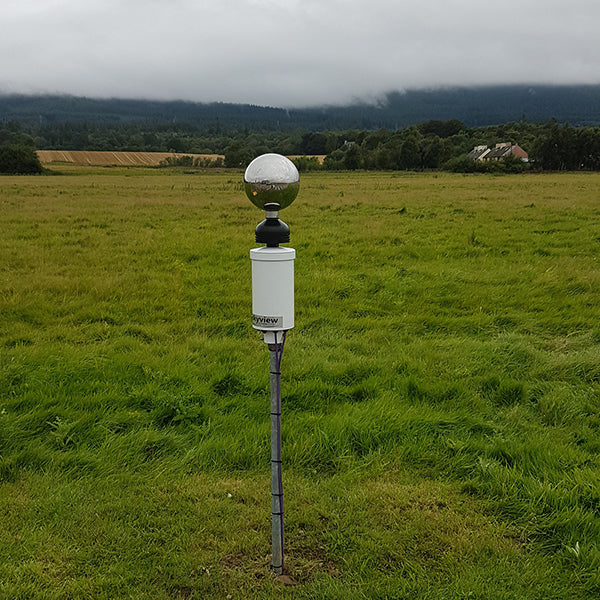
9 Church Field Road, Sudbury, Suffolk, CO10 2YA
Skyview Systems' real-time lightning detection and warning systems are engineered to safeguard lives, infrastructure, and operations across the UK. With over 1.4 billion lightning events detected globally each year, the need for accurate, fast-response lightning monitoring is critical. Our cutting-edge detectors provide instant alerts, enabling proactive safety protocols in high-risk industries such as aviation, energy, construction, and logistics. By delivering real-time strike data, our systems help maintain operational continuity and ensure workforce safety during severe weather events.
Though lightning strikes may appear vast across the sky, they typically measure only 2–3 cm in width, yet can stretch over 2–3 miles in length, posing serious threats to ground-level operations. Thunderstorms result in hundreds of billions in global damages annually, reinforcing the importance of robust lightning strike detection. Skyview Systems offers fully integrated, UK-compliant lightning monitoring solutions that support both regulatory compliance and extreme weather resilience. Whether you need permanent systems or mobile units, our lightning meter detectors deliver unmatched accuracy when it matters most.
Lightning detection systems are vital tools for accurately tracking lightning activity and ensuring safety across a wide range of sectors in the UK. From meteorology and renewable energy to aviation, construction, and public safety, these systems enable informed decision-making, reduce operational risk, and optimise critical workflows.
Whether you're monitoring severe weather, scheduling high-risk work, or implementing robust safety protocols, advanced lightning detection solutions deliver the precise, real-time data needed to improve performance and resilience. Discover how Skyview’s cutting-edge lightning detection technology can enhance your operations with reliable, actionable insights across diverse applications throughout the UK.

Real-time lightning detection systems protect aircraft, ground crews, and airside operations, minimising delays and ensuring safety compliance.

Protect wind turbines and solar farms from costly downtime with early lightning alerts that reduce equipment damage and optimise site uptime.

Lightning alert technology safeguards workers, heavy equipment, and project timelines during severe storms, reducing liability and delays.
)
The BTD-200 Lightning Warning System is a complete, out-of-the-box, self-contained sensor that reliably detects the presence of all forms of lightning to a range of 35km. The BTD-200 uses quasi-electrostatic measurements to avoid the problems associated with the detection of lightning using radio waves and to provide the ability to issue warnings prior to the first discharge of lightning.
The advanced detection principle of the BTD-200 enables it to monitor the strength of the local electric field and the presence of charged precipitation, both of which are strong indicators of lightning risk. This allows the BTD-200 to provide warnings of the risk of an overhead strike even before any lightning has been produced. This advance warning can be up to 20 minutes before the lightning begins, giving more than enough time to alert staff, members, teams and the public to the risks of remaining out of doors.
A lightning detector (sometimes referred to as a lightning meter or sensor) is a device that identifies and measures lightning activity in the nearby area. It provides real-time data on lightning strikes, helping users evaluate risk and take preventive measures.
A lightning alert system detects electrical discharges within a defined radius and automatically sends visual, audible, or digital alerts (e.g., SMS or app notifications). This early warning allows people to take safety precautions and reduce lightning-related hazards.
Lightning strike detectors and sensors are commonly used in areas prone to thunderstorms. They provide real-time monitoring of strike activity to protect individuals, equipment, and structures by issuing alerts before a lightning strike causes harm or disruption.
A lightning strike detection system is an integrated solution comprising multiple sensors, data loggers, and communication tools. It monitors and records lightning strikes within a designated area and delivers accurate alerts and data for safety planning and analysis.
When professionally installed and regularly maintained, lightning detection systems are highly reliable. Modern systems use advanced sensing technology to detect strikes with high accuracy, often achieving over 95% detection efficiency and minimal false alarms.
When choosing a lightning detector or sensor, consider features such as:
Commercial lightning detectors are vital for industries such as construction, aviation, energy, and outdoor events. They help safeguard personnel and infrastructure, minimise operational downtime, and support compliance with health and safety regulations.
Commercial lightning sensors are designed for robust performance in larger or critical environments. They typically offer broader detection coverage, longer service life, and enhanced integration options. Standard detectors are more compact and suited to personal or small-scale use.